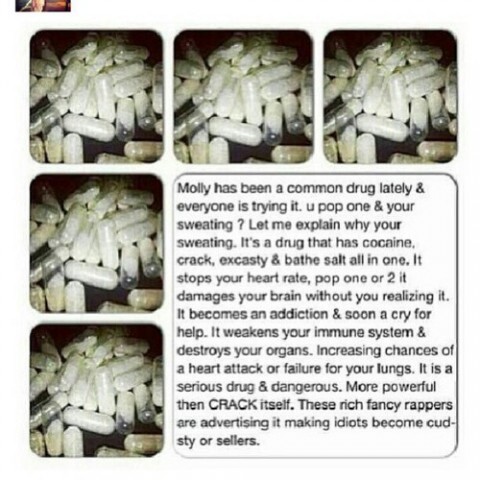Molly Madness (Remix)
What you’re about to read is an extended version of “Molly Madness” which I wrote for Ebony.com. They edited and produced a piece which is very much to my liking but after subsequent discussions with some folks I decided it’d be good to post the unabridged version. This version contains more information on molly/MDMA as well as resources on research about drugs, harm reduction, and importantly how to talk to your kids about drugs in a way that will keep them safe, not make them think you’re a NARC, out of touch, or scared they’re going to end up like Pookie (your kids won’t get this reference but you likely will). This is a subject I wrote on because I was/am concerned about the harm misinformation can do and even went as far as to consult a good colleague and friend who does work on drugs, addiction, and harm reduction (you’ll see him shouted out below). Enjoy!
“Popped a Molly I’m sweating, Whoooo!” – Trinidad James
If this refrain is not familiar to you, you should get familiar. In the past year, the Hip-Hop industry has been discussing the street drug “Molly” and the controversy, confusion, and hysteria over it should have us all sweating.
What is Molly?
Widespread mentions in hip-hop and electronic music have left many asking, “what is Molly?” At base, Molly is a street slang for a powder or crystal form of MDMA—methylenedioxymethamphetamine—more commonly known as ecstasy. Now here is where it gets a little bit tricky, with an unregulated drug market what comes in a pill that is sold on the street may differ from what it is called. While every pill called Molly may not be “pure MDMA” there have been long standing non-profit efforts to research “what’s in it?” like Ectasydata.org and DanceSafe.org which test street drugs for the contents in order to inform users so they can reduce harm.
Even still, there is a fear-based campaign emerging that Molly is the “new crack.” Recently on social media I’ve seen a number of images floating around that argue that are designed to “inform” readers about Molly and its harms. One reads, “It’s a drug that has cocaine, crack, excasty [sic] & bathe salt all in one. It stops your heart rate, pop one or 2 it damages your brain without you realizing it.” The image goes on to talk about the damage it does to your immune system and claims the drug is “more powerful then CRACK itself” and that rappers are responsible for the impending death of a nation. There is only one problem with this, nearly every claim is false, fear-inducing, and likely does less to help us deal with drugs than to stigmatize drug users and the culture of Hip-Hop.
As a Hip-Hop head of the 90s I can remember conversations with peers and friends about “blunts”, “chronic” and “illy.” I remember being told, “the chronic is weed with crack mixed in it”, “blunts are pure weed in phillies” and “illy is sess mixed with embalming fluid.” This was a conversation among teenagers and as well intended as it was, it was grossly misinformed. And more importantly, didn’t really stop anyone in my generation from seeing if Bill Clinton’s claims were possible. The conversation I’m hearing about Molly today reminds me of those conversations!
Hip-Hop just “discovered” Molly; Molly is not a new drug! Across race, class, and nation, discussions of Molly have been ongoing and serious discussions about its use and consequences are becoming more common. The reality is thatmany youth and adults will experiment with drugs; ecstasy being among them (ecstasy users tend to be younger). Contrary to hysteria about Molly, there is little evidence that it is more harmful than many legalized drugs like alcohol. Yes, read that again, recent scientific research has not found ecstasy is often more stigmatized (by governments and everyday people) than it is actually harmful to users or communities. That doesn’t mean I want your children to do it, but it does mean that we have to be realistic about consequences and have informed conversations.
This is Your Hip-Hop on Drugs
Drugs are not new, hip-hop is not new, but maybe our approach to talking about them should be. Hip-Hop and the Black community have had a precarious relationship with drug use to say the least. In 1983, the now classic song “White Lines” by Grandmaster Flash and Melle Mel was released which warned against the use and selling of cocaine. The song featured a funk-laden baseline, which framed cocaine use as more of a social problem than a social stimulant. For some, this was the start of Hip-Hop’s support of the anti-drug movement, but this was not the only view on cocaine at the time.
In 1984, Funk Master Wizard Wiz released an ode to the newly arrived drug crack cocaine called, “Crack it up.” As the individual and communal impacts of crack cocaine became more clear there was a public rebuke of the record causing Tuff City Records and Funk Master Wizard Wiz to add “you better not” before the song’s original refrain of “crack it up.” The public pressure to make the song explicitly “anti-crack” was fueled by a fear that the song glorified the use of the drugs and rap would spread the influence of crack. The spread of the crack ultimately had little to do with music and much more to do with poverty and the media’s fascination with a new “demon drug.”
Most drug education in the United States comes from casual conversation, campaigns to abstain, and drug enforcement policy from the government. This often means that drug use is misunderstood and punitively dealt with, rather than a rehabilitative approach that considers individual and community well-being. Michelle Alexander’s book “The New Jim Crow” has masterfully demonstrated the impacts of such policies on the Black community. Furthermore, it is socially dangerous to rely on rumor and abstinence only approach. Ironically, the message of abstinence advanced in “White Lines” by Grandmaster Flash and Melle Mel did not deter them from using and eventually abusing cocaine. We need to have a different conversation about drugs that are based in reality and responsibility.
Like the Reefer Madness propaganda of the twentieth century the emergent concern and fascination with Molly is likely misdirected. Ecstasy is far closer to marijuana than crack in individual and collective consequences. Weaving narratives of community destruction, instant addiction, and moral decay will not deter people from trying drugs and will only further stigmatize and likely criminalize drug users. The only way to break Molly Madness is to have responsible and accurate conversations about drug use, drug abuse, individual and community impacts. While a song may start a dialogue, it is our responsibility to continue the discussion with sound information and realistic approaches to drugs in our communities, not fear and fantasy.
Special thanks to Jack Levinson, PhD for resources on this article.
Filed under: Activism, Black Men, Black Women, Food for Thought, Politics, Prison, Race, Youth



